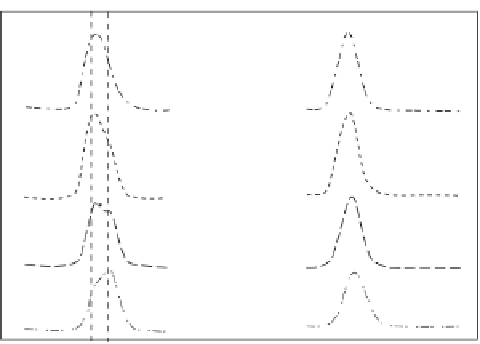Biomedical Engineering Reference
In-Depth Information
BO
NBO
O
1s
Si
2p
59
55
50
42
532
528
106
102
98
536
Binding Energy (eV)
Figure 11.22.
XPS spectra of O
1s
and Si
2p
photoelectrons for different bioactive glass coat-
ings. From [Liste, 2004b].
These facts evidence the rearrangement of the coating silica network towards
a more organized structure.
In order to clarify the chemical bonding of the bioactive glass coatings, X-ray
induced Photoelectron Spectroscopy (XPS) analyses were carried out. The O
1s
and Si
2p
photoelectron spectra of different coatings are shown in Figure 11.22. The
O
1s
photopeak can be studied to provide useful information on the bonding states
of the oxide ions in the silicate glasses. The curve fi tting of the O
1s
photoelectron
spectrum shows two well-resolved peaks around 532 and 530 eV, associated with
the bridging silicon-oxygen groups (BO) and non-bridging silicon-oxygen groups
(NBO) respectively. When the silica content of the bioactive glasses is increased,
two important effects are observed: variations in the intensity of the BO and
NBO bands; and the shift of the binding energies of the photopeaks (O
1s
and Si
2p
)
towards higher values.
These results are associated with a change in the chemical environment of the
silica structural unit. The vitreous silica structure is formed by SiO
4
tetrahedra
connected by BO groups. If network modifi ers (Na
+
, K
+
, Ca
2+
and Mg
2+
) are added
to the silica network, the peak intensity corresponding to BO groups decreases
due to the formation of NBO groups. The ions induce structural changes leading
to the breaking of Si-O-Si groups between adjacent tetrahedra. The charge is
compensated by the formation of NBO groups which are associated with a nearby
alkali or alkali earth ion.
Fourier Transform Infrared and X-ray Induced Photoelectron Spectroscopies
show that the physico-chemical properties of the bioactive glass coatings grown
by laser ablation can be fi nely tuned. Therefore, the reactivity of the glass coatings
can be controled when they are exposed to physiological fl uids. This fact is dem-
onstrated [Liste, 2004b] by a comparative
in vitro
study of the bioactive behaviour


Search WWH ::

Custom Search